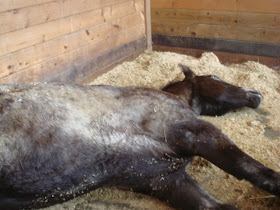This is Cricket's 2nd founder event. She came here in chronic pain. She was rehabbed within 5 months and was doing well until she was put into a situation that sent her back into acute laminitis.
In my opinion, each time a horse goes into acute laminitis, then founder, the subsequent damage to the laminae is worsened with each event. I suspect that is due to the fact that after foundering, a hoof doesn't ever completely return to the state that it was before the first event due to the damage incurred by the laminae and solar papilae - once compromised, always compromised, at least to some degree. This my not be true in every case, but possibly in most cases.
So Cricket just could not tolerate the pain associated with standing on three hooves. I tried everything I could think of and became very frustrated with her lack of cooperation, but at the same time, I knew she was in a lot of pain. I tried mass doses of pain reliever and finally raising her in a sling, which I thought was my last resort at the time. But this smart little mare prooved me wrong.
For a long time, I couldn't do anything with her feet to help her and the condition of her hooves was really becoming a huge concern. Her frogs were getting extremely thrushy as well, so I knew that was causing much of the pain she was experiencing.
Feeling defeated, I was beginning to wonder if the kindest thing for me to do for her was to put her down.
 Cricket laying down for me so I would work on her hooves.
Cricket laying down for me so I would work on her hooves. But I started going into her stall with my tools anytime I found her laying down on her chest and I'd ask her to lay down completely on her side. Surprisingly she complied the first few times I did that!
Now, everytime I walk into her stall with my tools, I say, "Lay down Cricket" and she complies. She clearly seems to understand that I'm trying to help her and she's letting me know this is the only way she can grant me access to the bottoms of her hooves. It's pretty amazing and cute!
 Partially trimmed founder hoof.
Partially trimmed founder hoof.Sometimes she lets out a big sigh, like "Oh good grief, this again...here you go."
Horses are so smart! What more can I say?
Some of you have had questions about lamintis and founder and are confused about the two, how they relate, and the causes. If you would like me to explain what causes laminitis, please let me know and I'll be happy to do that here.
Thanks,
Pat

If you would be so kind to explain more about laminitis and founder... I have done research online, but I've found that you have a knack for explaining complicated things in an easy-to-understand way (probably because you have experience with it and some SOLUTIONS!)
ReplyDeleteWould love to hear your take!
And yes, that little mare is SMART!
Yes, please explain..pease, please, please.
ReplyDeleteI have a mammoth donkey who has had laminitis. I am still dealing with her hoof issues. We have dead build up laminae sole that won't come out yet.
I would like to know the difference too, even though I am no longer in horses. I consider all information to be useful in one form or another. :)
ReplyDeleteOh and I love the stories about the horses you work on! They are always great to read especially when I'm having a bad day.
Thank you so much!
Awesome, I'm working on the next post. There is quite a lot to say in explaining the difference so it will be a long post.
ReplyDeleteMegan, I'm especially pleased that my stories can help you in some small way. Even someone who doesn't have horses can relate. That's very cool.
I'm considering submitting a book for publication called "The Ramblings of a Natural Hoofcare Practitioner" because that's essentially what I do when I'm trying to explain technical information. I share my own experiences, etc. And not just on here, but also on the AHA forum. I go on and on and then I wonder if I'm boring the other practitioners to death. Then my daughter agreed that as much time as I spend writing, I should try to publish a book!
So I think I will and all proceeds from the book will go toward the care and feeding of the horses at the Rainier Hoof Recovery Center.
Pat - i can usually take the smallest bit of information about animals and apply it to something else. I do this a lot with dogs because how you interact with a dog can be translated to how you interact with kids or horses or other human beings. Everythign relates... so keep the stories coming. I'm going to read your newest post in a few minutes. :)
ReplyDelete